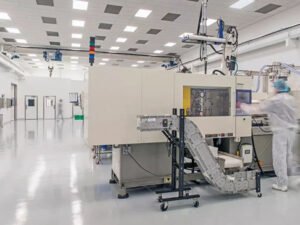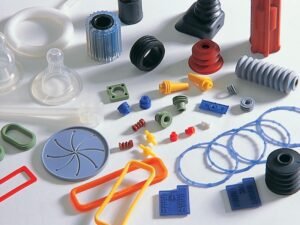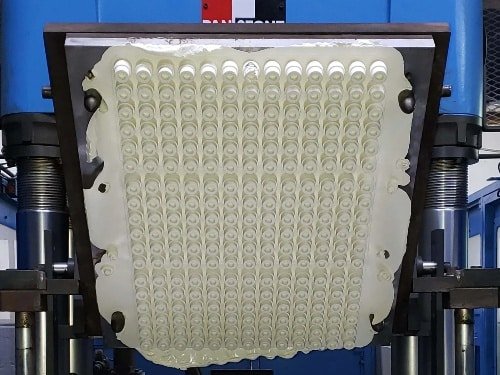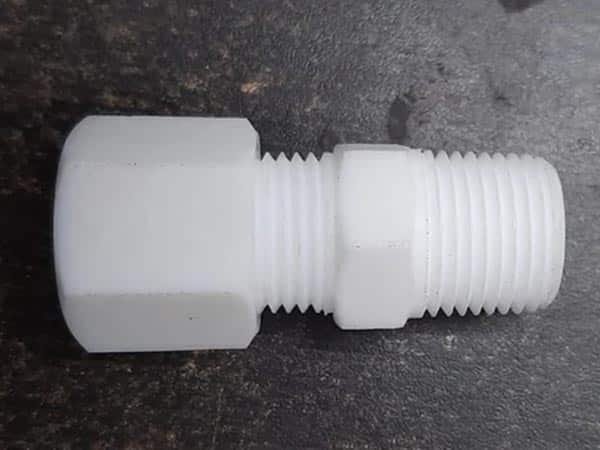Medical silicone molding is an important technology for both implantable and non-implantable medical components. Implantable parts, such as seals in pacemakers or catheter tips, remain inside the body for extended periods and require long-term stability. Non-implantable parts, including surgical instrument handles or respiratory masks, contact the body temporarily and focus on ease of sterilization. This dual capability allows medical silicone molding and silicone material to address diverse needs in medical device design.
What is Medical Grade Silicone Types?
Solid Silicone Rubber (HCR)
Solid silicone rubber, also known as high consistency rubber, is a high-viscosity, paste-like material that is typically processed through compression or transfer molding. It offers high mechanical strength, excellent elasticity, and strong tear resistance, making it suitable for applications that demand durability and resilience.
Advantages of Solid Silicone Rubber (HCR):
- Biocompatible material that meets ISO 10993, USP Class VI, and RoHS standards.
- High mechanical strength and tear resistance, suitable for durable medical parts.
- Excellent heat resistance, maintaining performance from -50°F to 450°F.
- Good compression set and long-term elasticity under repeated stress.
- Superior dimensional stability, ideal for precision components and seals.
- Can be sterilized by autoclave, ETO, or gamma radiation without degradation.
- Customizable formulations to achieve specific hardness or color requirements.
Liquid Silicone Rubber (LSR)
Liquid silicone rubber (LSR) is a two-part, platinum-cured silicone material with low viscosity, suitable for injection molding and high-volume automated production. It is known for its excellent flexibility, tear strength, and high purity, ensuring outstanding biocompatibility for medical applications.
Benifits of Liquid Silicone Rubber (LSR):
- Biocompatible and bio-inert, compliant with ISO 10993, USP Class VI, and RoHS standards.
- Easily sterilized using methods such as autoclave, ETO, E-beam, or gamma radiation.
- Low viscosity allows LSR to flow into intricate mold details for precise parts.
- Excellent heat stability, performing reliably between 150°F and 450°F.
- Low compression set, maintaining shape and elasticity over long-term use.
- Self-adhesive grades bond to plastics without primers, simplifying overmolding.
- Consistent flexibility and resilience even under extreme temperature conditions.
Common Standards for Medical-Grade Silicone
Because silicone components are often used in direct contact with human tissue or fluids, they must comply with strict international standards. The following are the most recognized benchmarks for medical-grade silicone materials:
| Standard | Description |
|---|---|
| USP Class VI | Ensures the silicone material passes biological reactivity tests for systemic toxicity, intracutaneous reactivity, and implantation safety. |
| ISO 10993 | Provides guidelines for evaluating biocompatibility, including cytotoxicity, sensitization, irritation, and systemic effects. |
| FDA 21 CFR 177.2600 | Defines requirements for materials in contact with food or biological systems, ensuring non-toxicity and chemical stability under standard use conditions. |
Medical Silicone Molding Methods
Liquid Injection Molding (LIM)
This is the most advanced and widely used technique for producing medical silicone components. In medical silicone injection molding, two parts of liquid silicone rubber are precisely mixed and injected into a heated mold cavity. The material cures quickly, forming high-precision parts with consistent dimensions.
The advantages of LIM include high automation, excellent repeatability, minimal waste, and suitability for cleanroom production. This process is ideal for high-volume manufacturing of components like catheters, diaphragms, and implantable seals.
Silicone Compression Molding
Compression molding is commonly used for high-consistency rubber materials. In this process, pre-measured silicone material is placed into a heated mold cavity and compressed under pressure until cured. Although slower than injection molding, it allows the production of large or thick-walled parts without complicated equipment.
Its advantages include lower tooling costs, suitability for smaller batch production, and flexibility in material selection. It is often used for non-implantable products such as plugs, sheets, and O-rings.
Silicone Transfer Molding
Transfer molding combines features of both compression and injection methods. The silicone material is preheated in a chamber and then forced into the mold through a runner system. This technique ensures better dimensional control than compression molding and supports parts with inserts or multiple cavities. It is suitable for complex geometries that require uniform pressure distribution and consistent curing.
Cleanroom Manufacturing for Medical Silicone Components
Producing medical silicone components that meet stringent cleanliness and biocompatibility standards requires careful control from raw material handling to final packaging.

Silicone Molding Cleanroon Standard
Silicone molding cleanrooms are designed and operated in accordance with ISO 14644 standards, which classify cleanrooms based on airborne particulate concentration. Measurements typically cover particles ranging from 0.1 to 5 microns per cubic foot of air. For medical-grade silicone molding, Class 7 (10,000) cleanrooms are generally required for Class II short-term implantable or disposable medical devices, while Class 5 (100) environments are used for Class III implant-grade components.
Cleanrooms use laminar airflow systems and HEPA filtration to continuously remove airborne particles. Equipment layout, material flow, and personnel movement are also managed to minimize contamination risks.
Raw Material Handling
Raw material preparation occurs in the cleanest sections of the cleanroom to prevent contamination. Medical grade silicone for molding enters the process under controlled conditions, ensuring no external particulates affect the batch.
Cleaning and Molding
During medical silicone molding, mechanical and thermal processes can generate particulates. As a result, all molded components undergo a post-molding cleaning process within the same cleanroom environment. Cleaning removes residual particulates or surface contaminants before packaging.
Here is a point. Cleaning differs from sterilization. Cleaning ensures that silicone molded parts leave the production facility in a contaminant-free condition, while sterilization, usually performed by the OEM, eliminates microorganisms and ensures compliance with FDA and international standards.
Applications of Medical Silicone Molding
Medical silicone molding applies to devices across FDA classifications. Class III is long-term implantable devices, used from 30 days to indefinite periods. These require implantable silicone. Class II is short-term implantable devices, limited to 29 days or less. These use medical grade silicone for molding. Class II disposables. These components also rely on medical grade silicone.

The common medical silicone components:
- Defibrillators
- Heart pumps
- Surgical reconstructive components
- Over-molded surgical blades
- Catheters
- Diagnostic guide wires
- Suture sleeves
- Disposable medical device components
- Optically clear ophthalmic lenses
- Orthopedic devices
- Needleless Connector
- Sleeve for needless connector
Impact of Medical-Grade Silicone on Healthcare
The impact of medical-grade molding extends far beyond manufacturing convenience. Its use has directly contributed to advancements in patient safety, comfort, and product performance. Silicone’s chemical stability ensures that it does not interact with bodily fluids or medications, reducing the risk of irritation or allergic reaction. Its flexibility and resilience allow for long-term use in both internal and external medical devices.
From a design perspective, medical silicone injection molding enables the production of micro-scale components, consistent sealing performance, and customizable shapes that were previously difficult to achieve. The ability to combine functionality with sterilization compatibility has accelerated innovation in medical device design and miniaturization.
Ask Zhongde About Medical Silicone Molding
Medical silicone molding has redefined the way medical components are produced, offering precision, biocompatibility, and design flexibility. For tailored solutions in silicone molding, consult Zhongde experts.

